Authentic Italian Cannoli Recipe (Sicilian)
Updated Aug 17, 2025, Published Oct 29, 2021
This post may contain affiliate links. Please read our disclosure policy.
Holy Cannoli! This is not just another Italian Cannoli Recipe. It’s the real deal, straight from my Italian kitchen to yours. It’s been perfected with love. You will find these crisp golden shells are filled with the creamiest, dreamiest ricotta filling you’ve ever tasted.
For more authentic Italian desserts, try my Cannoli Cake, Italian Tiramisu, and these Easy Italian Donuts next!
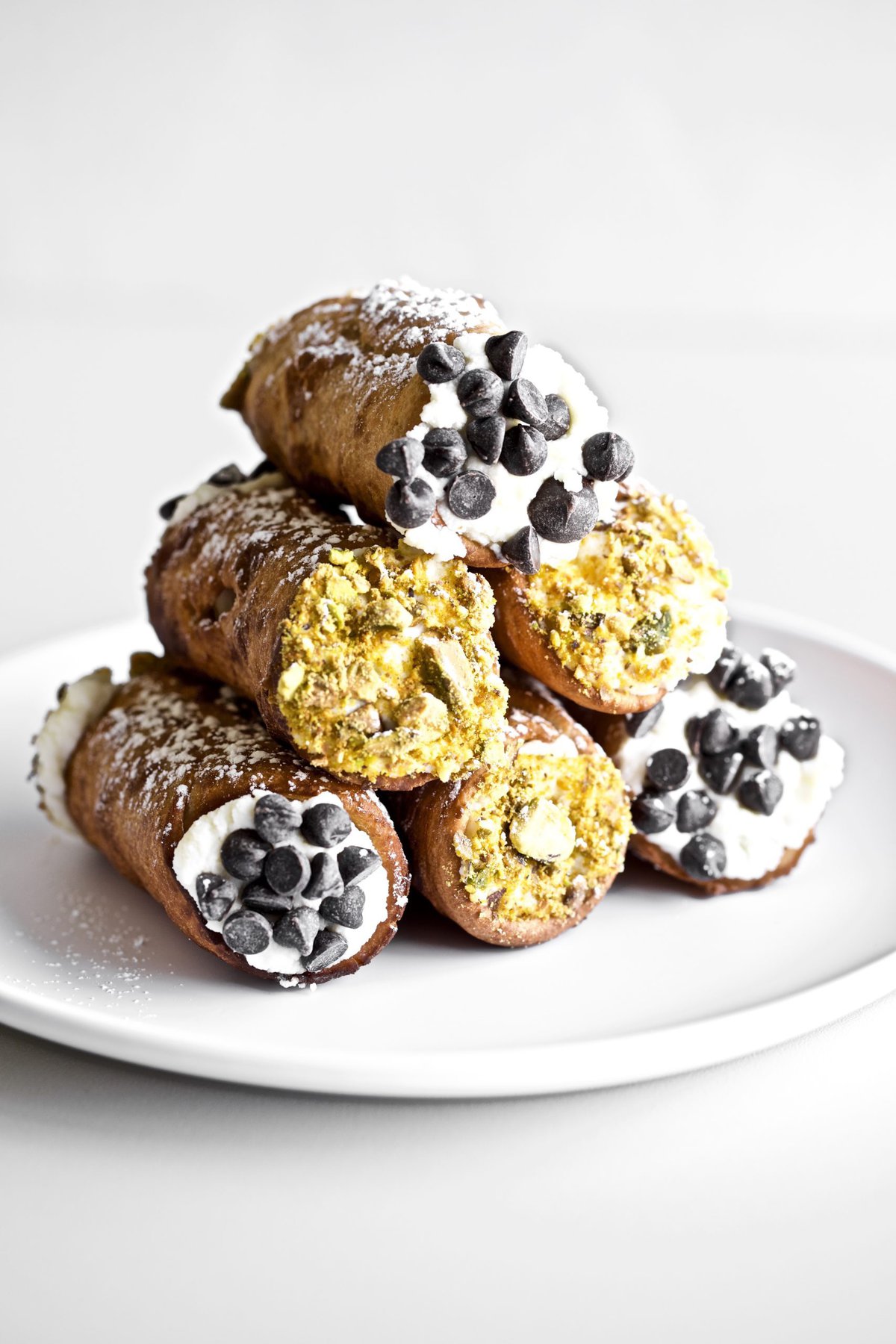
“Simply amazing! We made for the first time and they came out perfect and even impressed Italian family members. Thank you for always having the best recipes. I always say Cucina Elena never lets me down. ❤️”
– Lisa
Why you’ll love this family favorite!

Who doesn’t love Italian cannoli? The crunchy fried pastry shell is filled with a sweet creamy ricotta filling. Then the ends are dipped in various fun toppings of your choice!
You will be surprised by how easily this popular Italian cannoli dessert comes together! This recipe is straight from Sicily, the motherland of cannoli, thanks to my dear friend Lilli. This is her family’s Sicilian cannoli recipe that I’m sharing with all of you!
I’ll walk you through each step with photos so you can make this authentic cannoli recipe just like we do in Sicily. One bite, and you’ll taste the sweet soul of Italy. I hope you love it as much as we do, just like our cannoli dip.
Made With Amoré,

Table of Contents
Simple Ingredients
- Cocoa powder: Gives shells a rich color and slight bitterness to balance the sweet filling.
- Marsala wine: Adds a warm, subtle sweetness, helps create light, crisp shells, and keeps the dough tender for authentic Sicilian flavor. It’s also used to make these Italian fig cookies and in this steak Marsala recipe.
- Oil for frying: Use a neutral-flavored, high-heat oil that’s suitable for frying, such as vegetable or canola oil.
- Ricotta cheese: The base of any authentic Italian cannoli filling recipe! It’s lightly sweetened with powdered sugar. For best results, use a higher-quality ricotta. It has fewer additives and stabilizers, which ensures a smooth and creamy filling. If you’ve ever had very grainy ricotta, you know what I mean.
- Decorations for the ends: You can use candied orange slices or zest, crushed pistachios, chocolate chips, or marinated cherries for the ends of the cannoli.
See the recipe card for quantities. See the bottom of the post for step-by-step photo instructions.
Substitutions & Variations
- Ricotta Cheese Swaps: While I’m an Italian purest, which makes it hard to think of traditional cannoli without ricotta. Some other possible options include whipped cream cheese, mascarpone, or blended cottage cheese.
- Skip the Homemade Shells: If you’re in a hurry, you can buy pre-made cannoli shells instead of making them from scratch. Choose a quality product, like these by Frank & Sal Bakery. No matter where you buy them, they are a little bit expensive because of the labor that goes into making and storing them, since they break easily.
- Different Fillings: Cannoli filled with smooth Italian pastry cream aren’t traditional but provide a delicious variation. Fill your crispy, sweet, cannoli tubes with Italian chocolate pastry cream or the classic vanilla-flavored Italian Pastry Cream.
How To Make Cannoli
This authentic Italian cannoli recipe is easy to put together despite the long list of steps. Don’t worry, I am walking you through each step so you can easily make Sicilian cannoli in your own home. So grab all your ingredients, cannoli molds, and let’s get started.
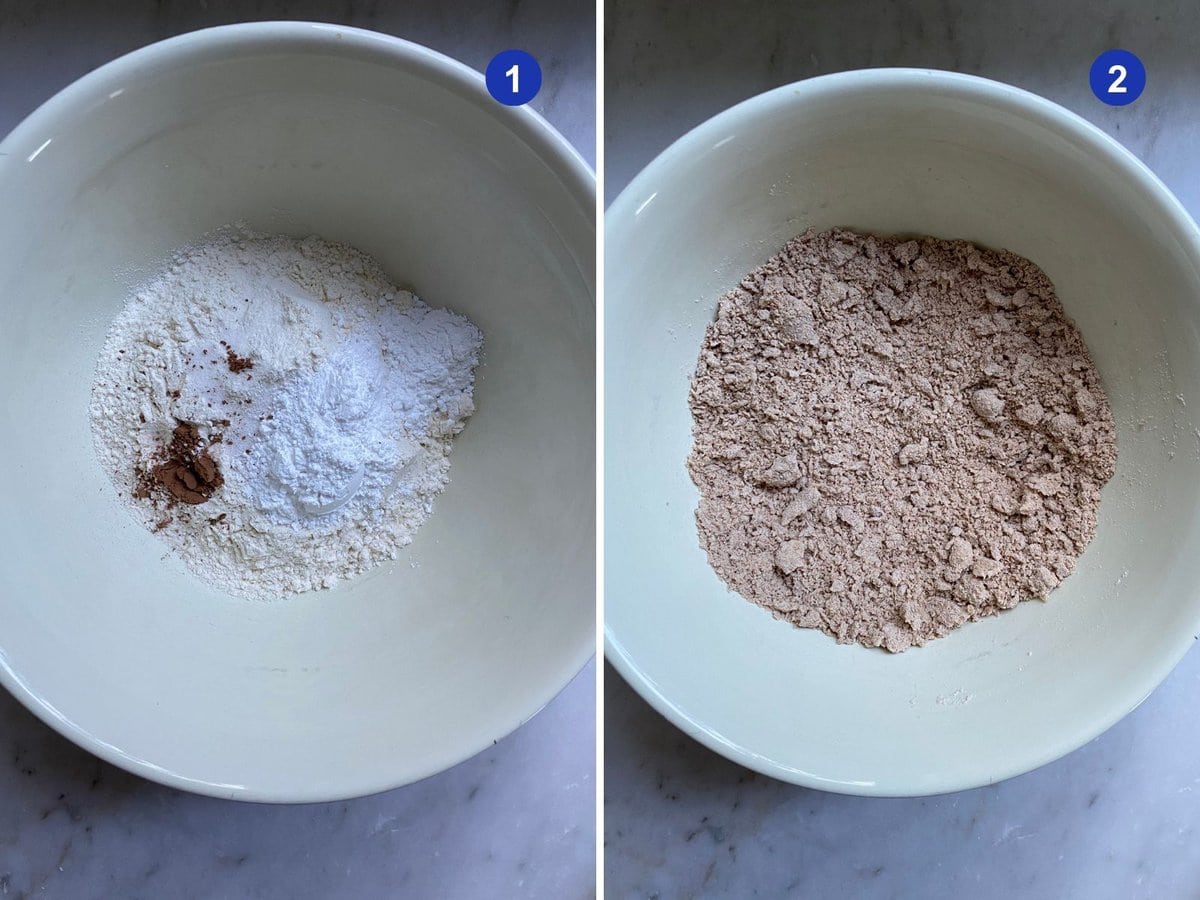
- Add the dry ingredients to a mixing bowl and mix together.
- Add the egg and butter and crumble by hand. Butter will remain in small chunks.
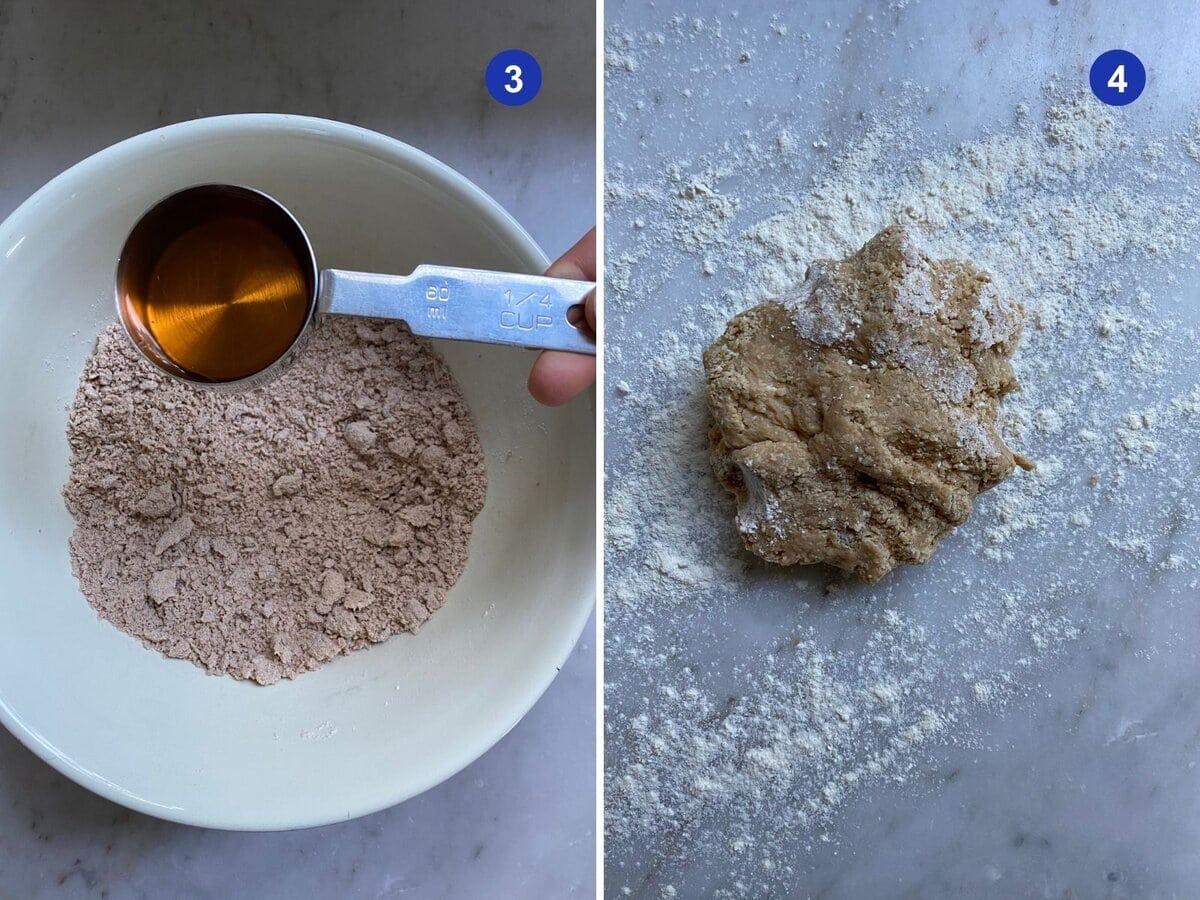
- Slowly add the wine a little at a time.
- Mix into the dough to form a soft, slightly sticky dough. Continue to mix until the dough forms a uniform mass and transfer to a floured surface.
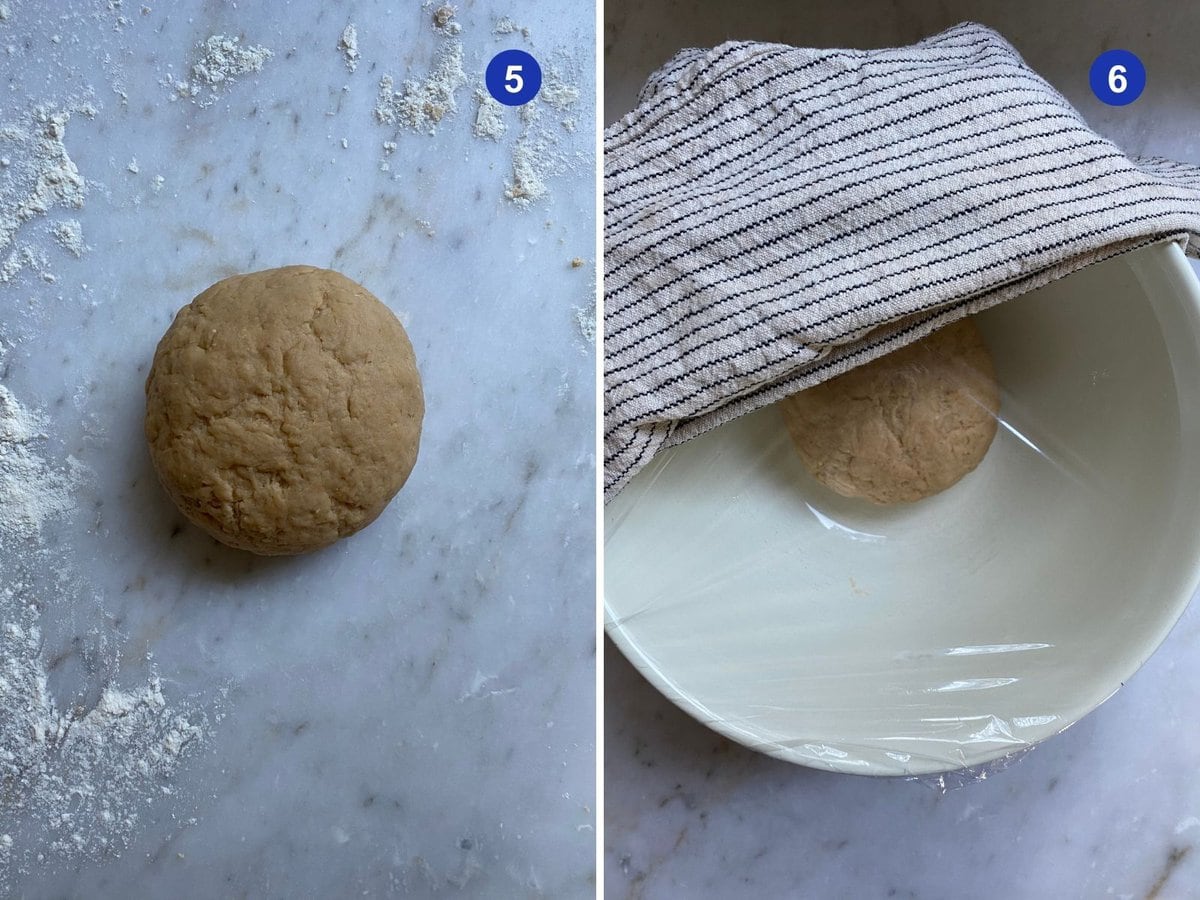
- Knead the dough for about 10 minutes. This will get the gluten working in the dough.
- Place the dough in a bowl. Cover with plastic and a cloth and rest for at least 30 minutes.
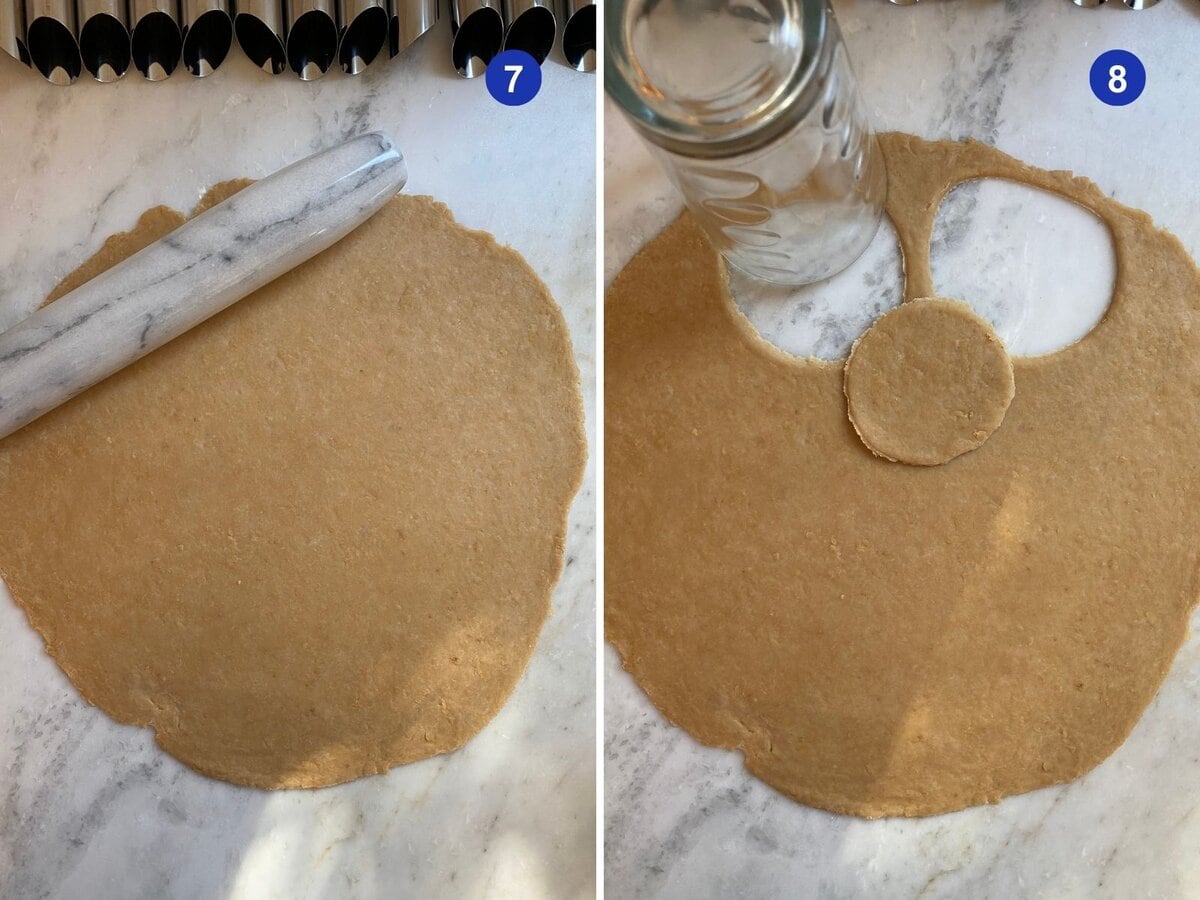
- Roll out the dough very thin using a rolling pin or a pasta machine. Thin dough is what makes the classic bubbles in the crust.
- Cut the dough into circles using a 3 1/2 inch – 4 inch cookie cutter or a glass.
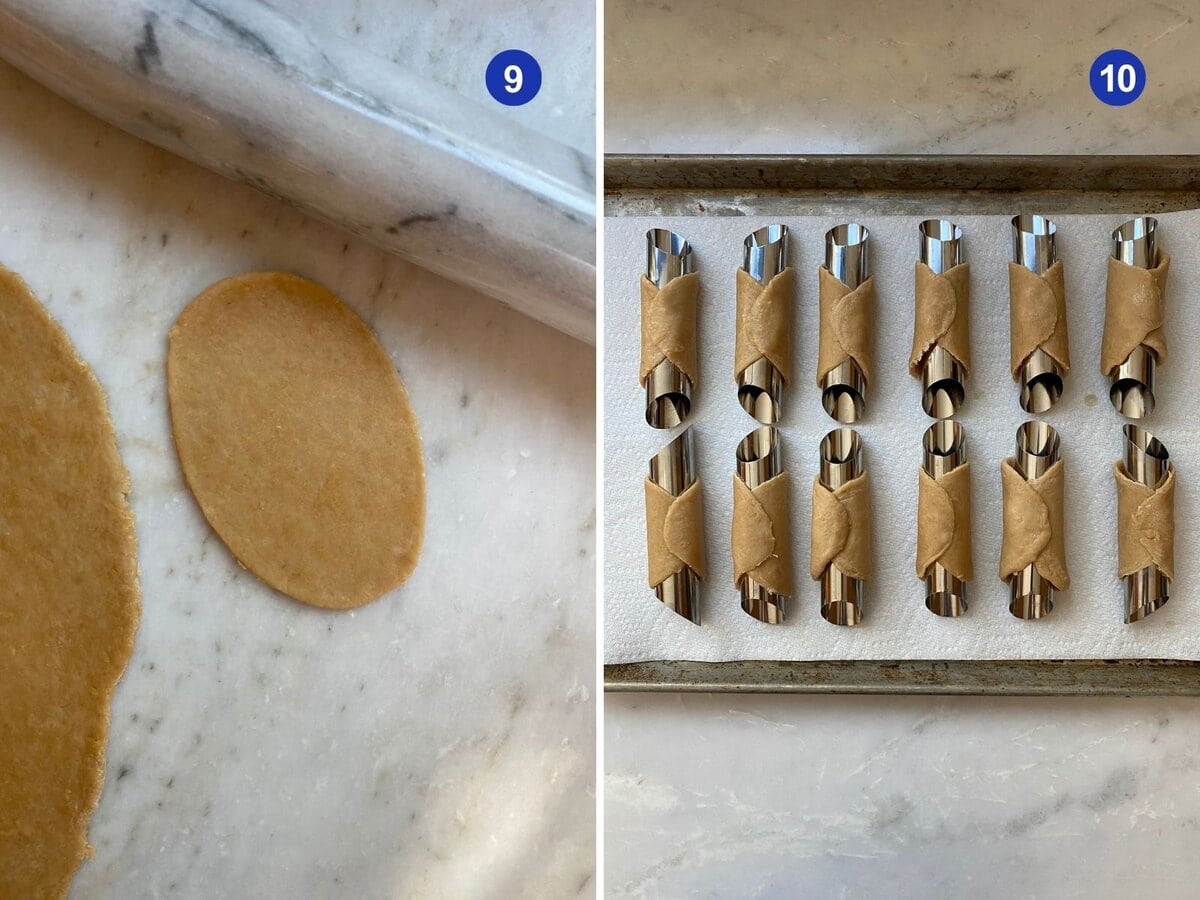
- If needed, roll each circle a little more after you cut the round shape.
- Carefully wrap each dough circle around the cannoli form. Do not press it onto the form. You want a little wiggle room for the dough to puff up in the frying oil. Use a bit of egg wash to press the edges of the dough together. This keep it from coming off the form when it hits the hot oil!
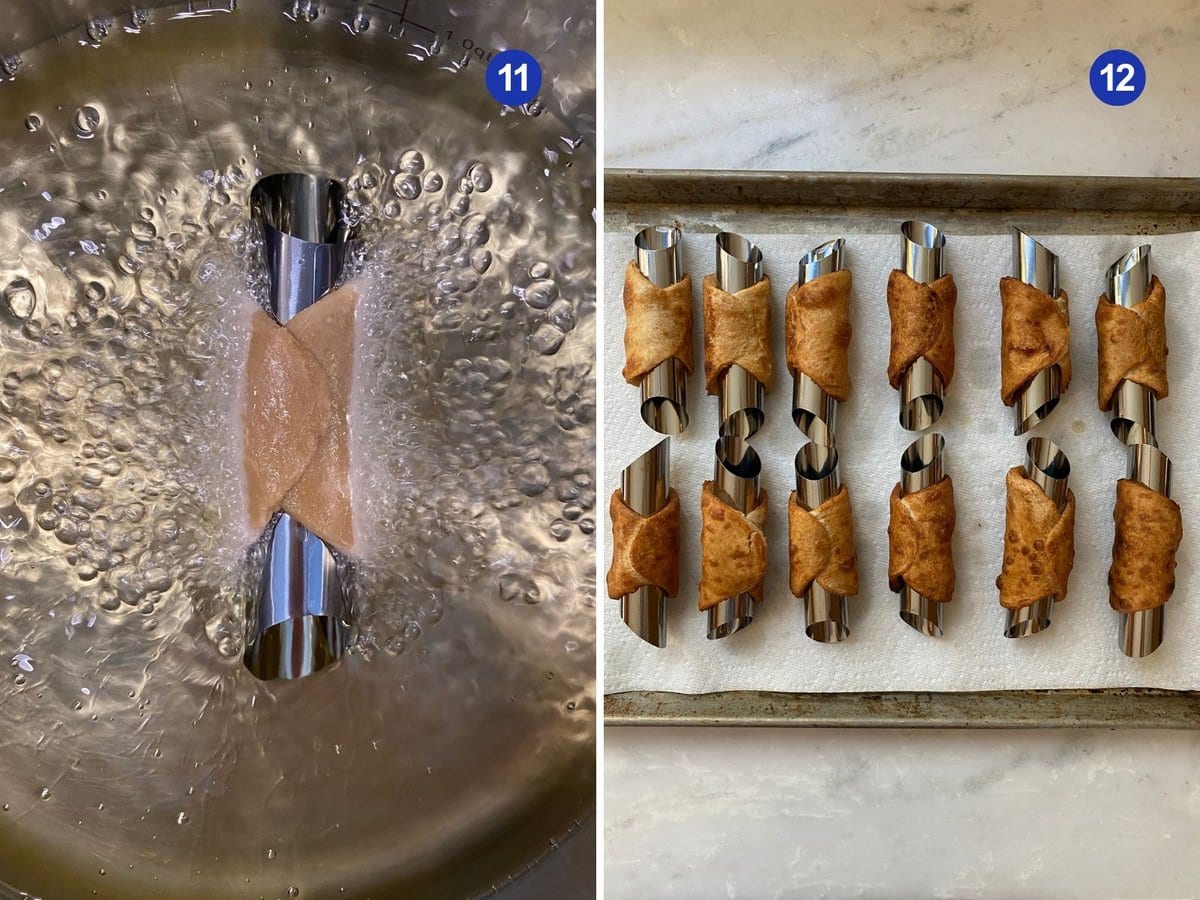
- Carefully fry the dough. Use tongs to handle the cannoli form. Always start with just one to make the temperature is right and you get a feel for how it moves in the oil. Add up to 4-6 at a time depending on your pot size.
- Let the fried dough cool and take off molds. Do not fill the shells when they are hot!
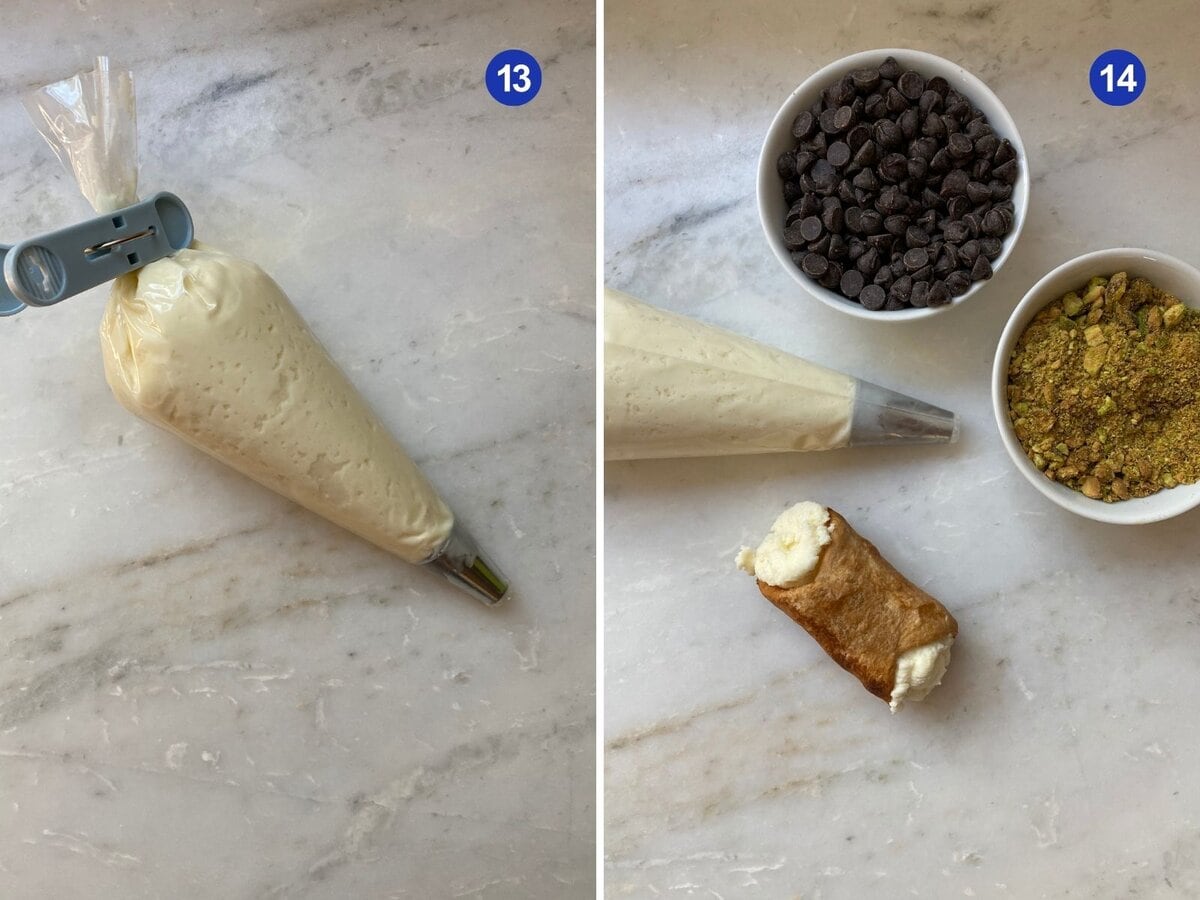
- Make the ricotta mixture for the filling while the dough cools. Transfer the ricotta to a pastry bag or a sandwich bag with the tip cut off.
- Fill the shells with the ricotta cream and dip the ends in your favorite toppings. I love crushed pistachios and chocolate shavings or chocolate chips. Enjoy!
If you love authentic Italian desserts like this Italian cannoli recipe, try this sweet ricotta pie, authentic Italian wedding cookies, and homemade Italian donuts with cream filling.
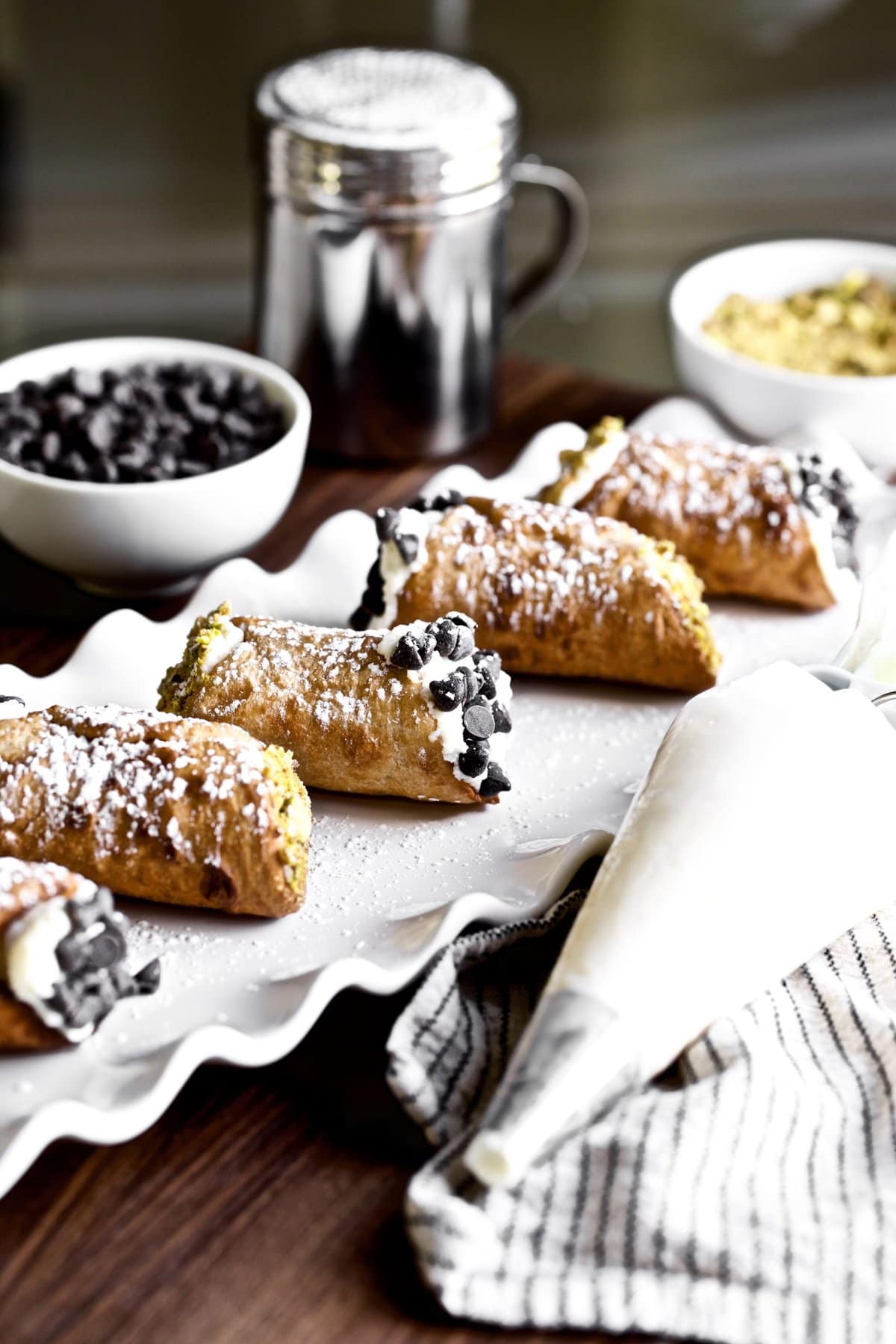
My Pro Tips
Italian Cannoli Recipe Tips
- Strain your ricotta well! This will ensure that the filling stays firm and doesn’t create a soggy crust.
- Don’t pre-fill the shells. You can make the shells ahead of time, but do not fill them until ready to serve.
- Feel the dough. This dough is similar to my homemade pappardelle pasta dough. It is firm and springs back slightly. For best results, you want to roll your dough out reasonably thin, about 1/16-inch. This will make them thick enough to fry while giving them a flaky texture. You can use a rolling pin or a pasta maker to roll it out.
- Heating your oil. The oil should stay at 375°F. If the dough gets too puffy it will retain oil and be too greasy. Use tongs to move the dough around and create an even fry.
- Use paper towels to remove shells. The mold will be very hot when you remove the shells for the next batch. Do not use your bare hands! Use a couple of paper towels to handle them.
- Don’t add too much sugar to the filling. It will loosen the ricotta and cause it to be runny.
- Storing Leftovers. Cannoli are best enjoyed fresh! However, you can store them in the fridge for one or two days. Just keep in mind they will lose a bit of their crispness.

Italian Cannoli Recipe FAQs
Cannoli are a classic and traditional dessert from Sicily. The singular form of cannoli is cannolo, a diminutive meaning ‘little tube’, from canna, ‘cane’ or ‘tube’. The traditional cannoli originated in the Sicilian city of Palermo.
It is believed that the cannoli’s filling originated with the Saracens, an ancient Arabic population, when they brought sugar cane to the region. This popular dessert was then served at the popular celebration of carnivale, a festival celebration before Lent. For festival goers, the cannoli became a symbol of fertility.
Place a strainer (or colander) over a large bowl so that there is at least an inch or two of space under the strainer above the bowl. Line the strainer with a few layers of cheesecloth or strong paper towels. Spoon the ricotta cheese on top of the cheesecloth and fold the cheesecloth around the cheese to contain it. Leave it covered in the fridge for 4 hours overnight.
If you already prepared your cannoli filling following the recipe and it still turned out watery, you can still salvage the cream. Drain off the excess liquid in your cannoli filling. Then, squeeze the liquid from more whole milk ricotta and add the dry cheese to the mixture. If it needs a little extra sweetness, adjust by adding a bit more sugar.
Yes, you can make the components for cannoli ahead of time. Fried cannoli shells store well both at room temperature for up to 2 days in an airtight container or bag. If you’re not serving them within a few days, freeze the shells for maximum freshness. You can also make the filling a day or two in advance and refrigerate it. The one thing to remember is, don’t fill the cannoli until just before serving time.
The best (and easiest) way is to use a pastry bag to fill the cannoli with the ricotta filling. If you don’t have a pastry bag, a plain old Ziploc bag with the tip cut off will do! This method is less messy and ensures the filling stays inside the cannoli instead of touching the outer part of the shell.
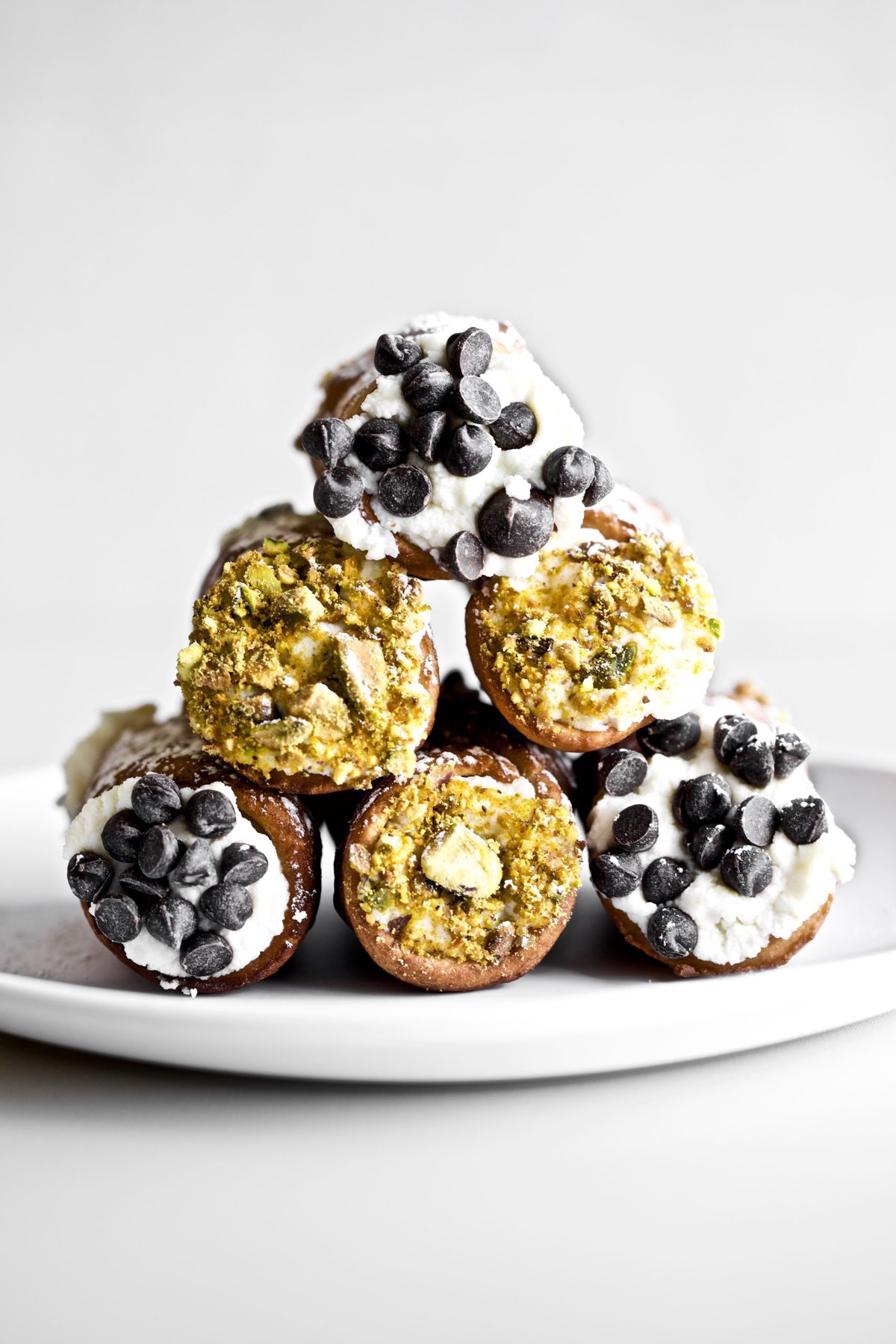
Serving Suggestions
Make this Italian cannoli recipe to enjoy anytime. They make a delicious dessert with a wide variety of meals, and a fun way to get the kids involved in making a dish.
Add to a dessert platter with my best lemon bars recipe and some Italian cream filled pastry. Or with these Chiacchiere di Carnevale, a popular Italian fried pastry.
Enjoy after a classic meal of homemade ravioli, my juicy Italian polpette recipe, or a plate of authentic fettuccine Alfredo.
More Authentic Italian Dessert Recipes
💙 MADE THIS RECIPE AND LOVED IT? 💙 Please leave a ⭐️STAR rating and COMMENT below- I love connecting with you! Tag me with your creations on Instagram and find me on Pinterest.
Best Sicilian Italian Cannoli Recipe

Equipment
- Cannoli Shells If you don't want to make them homemade.
Ingredients
Cannoli Dough
- 2 cups 00 flour, or all-purpose flour
- ¼ teaspoons cocoa powder
- 2 tablespoons confectioners sugar, granulated is fine as well
- 1 pinch salt
- 1 egg, well beaten
- ⅛ cup cold butter, cut in cubes
- ¼ cup Marsala wine, more if needed
- Vegetable or canola oil, for frying (about 8 cups)
- 1 egg, well beaten for egg wash to seal the dough around the cannoli form sticking
Cannoli Filling
- 3 cups ricotta cheese, stained (no liquid)
- ¾ cup powdered sugar, if you use granulated, it won’t be as smooth
- 1 pinch salt
- ½ cup mini chocolate chips, optional, but traditional, to put in the filling. I prefer without
Optional decorations for the ends:
- candied orange slices
- crushed pistachios
- chocolate chips
Instructions
Cannoli Shells
- In a large mixing bowl sift in flour, cocoa, powdered sugar and salt. Add egg and butter start to work with hands. Mix until crumbly and butter is in small pieces. Add marsala wine little by little until dough comes together. You may need to add a little extra wine here to create a soft doughy mixture.
- Take the dough out of the bowl and knead on a floured surface for an additional 10 minutes. Shape the well mixed dough into a ball and transfer to a bowl. Cover and let rest at room temperature at least 30 minutes and up to 2 hours.
- Heat a large pot with 1 1/2 inches vegetable oil to 345 – 355 degrees. Working with half the dough at a time (and keeping the other half covered in the bowl) roll the dough out very thinly onto a well-floured surface (nearly 1/16-inch). You can use a pasta machine to roll it out thin or a rolling pin will do.
- Using a 3 1/2 to 4-inch cookie cutter (or shape of a round glass cup), cut dough into rounds. Wrap dough circles around each cannoli mold, and brush about 3/4-inch of one end lightly with beaten egg (use a pastry brush or just your fingertip). Press the edge to the opposite side to seal the dough together around the cannoli form.
- Using metal tongs, carefully immerse the shell in preheated oil and fry until golden brown and crisp, about 1 – 2 minutes (be sure to watch oil temp so the oil doesn’t get too hot and burn shells. You can fry up to 6 at a time).
- Remove from oil using metal tongs to grasp the cannoli shell (let oil from inside forms drain back into pot), transfer to paper towels to drain. Use metal tongs to hold mold (or folded layers of paper towels) and wrap a paper towel around shell to carefully slide off of form.
- Let forms cool and repeat the process with the remaining dough circles. You can shake excess flour from the scraps, press them back together, cover in a bowl and let it relax at least 10 minutes, then reuse.
- Allow to cool on a wire rack then fill with cannoli filling and decorate as desired (with melted chocolate on edges, chopped pistachios, mini chocolate chips or dust tops with powdered sugar).
Cannoli Filling
- Whip the ricotta with a hand or a stand mixer, about 2-3 minutes. Sift the powdered sugar into the ricotta. Gently fold in the powdered sugar with a wooden spoon or spatula until smooth and combined. Then, fold in chocolate chips (if using).
- Transfer the filling into a piping bag fitted with a large round tip. Pipe filling into cooled cannoli shells. You can also cut off the tip with a spoon or a sandwich bag.
- Add the ricotta filling to a pastry bag. Squeeze it into the shells from each side, then dip in your desired topping (crushed pistachios, orange peel, or chocolate chips), and finish with a dusting of powdered sugar.
- For best results, fill your cannoli just before serving — or at the table in front of your guests!
Notes
- Strain your ricotta well to ensure that the filling stays firm and doesn’t create a soggy crust.
- You can make the shells ahead of time, but do not fill them until ready to serve.
- The mold will be very hot when you remove the shells for the next batch. Do not use your bare hands! Use a couple of paper towels to handle them.
- Don’t add too much sugar to the filling. It will loosen the ricotta and cause it to be runny.
Nutrition
Nutrition information is automatically calculated, so should only be used as an approximation.
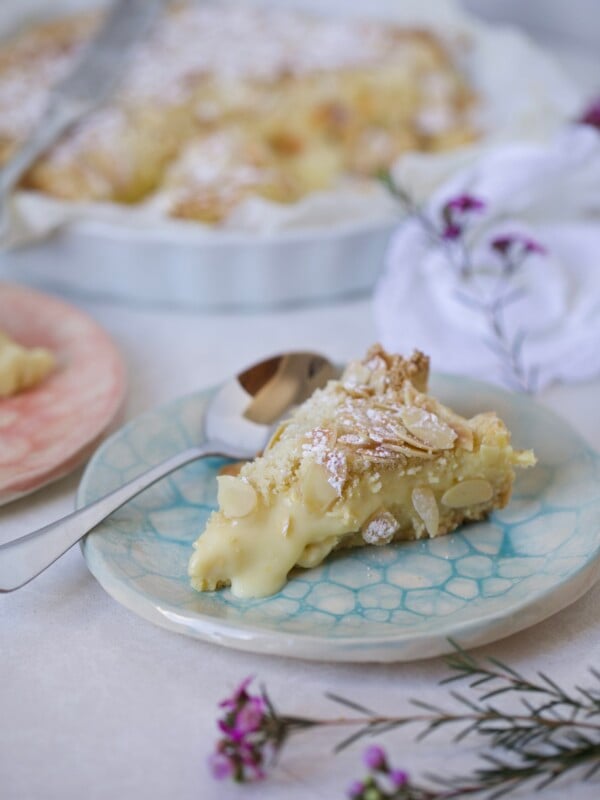
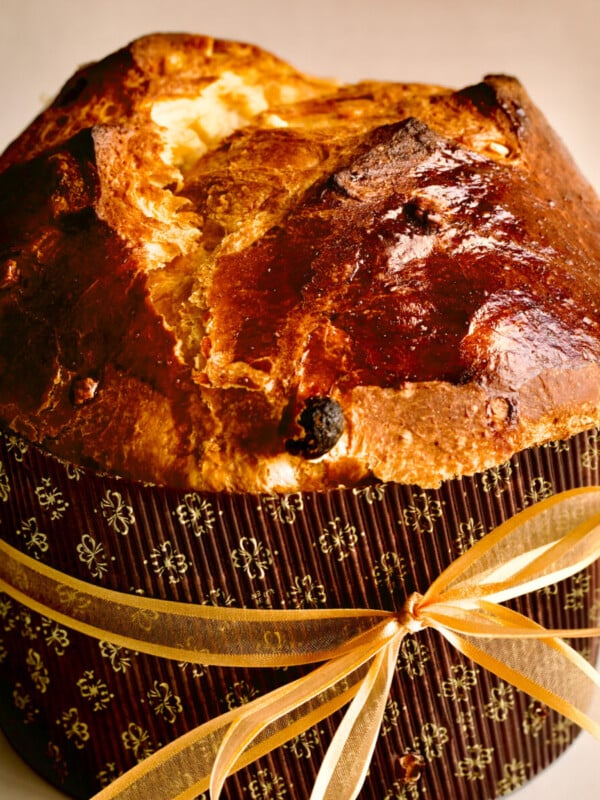
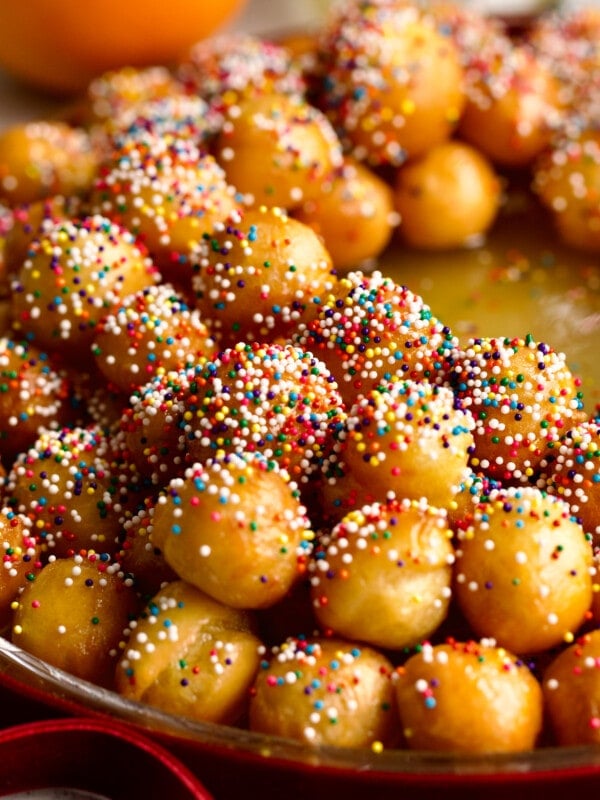
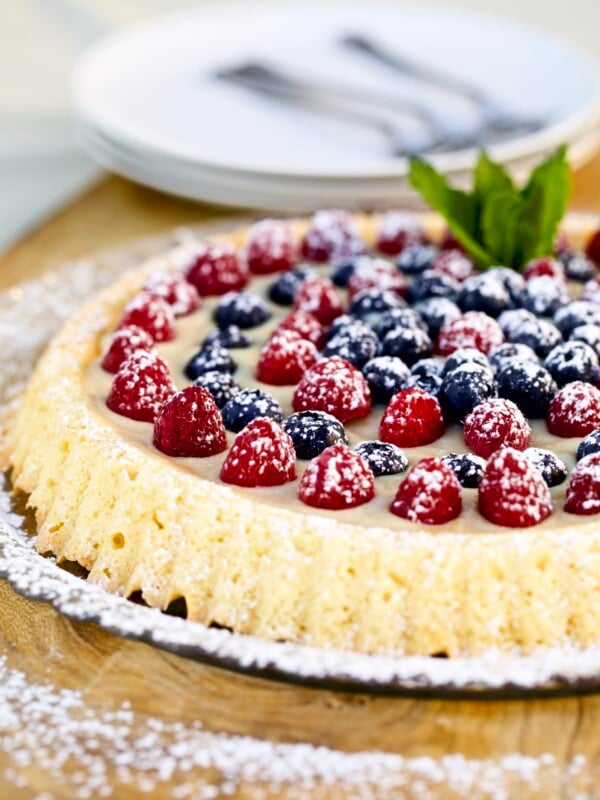
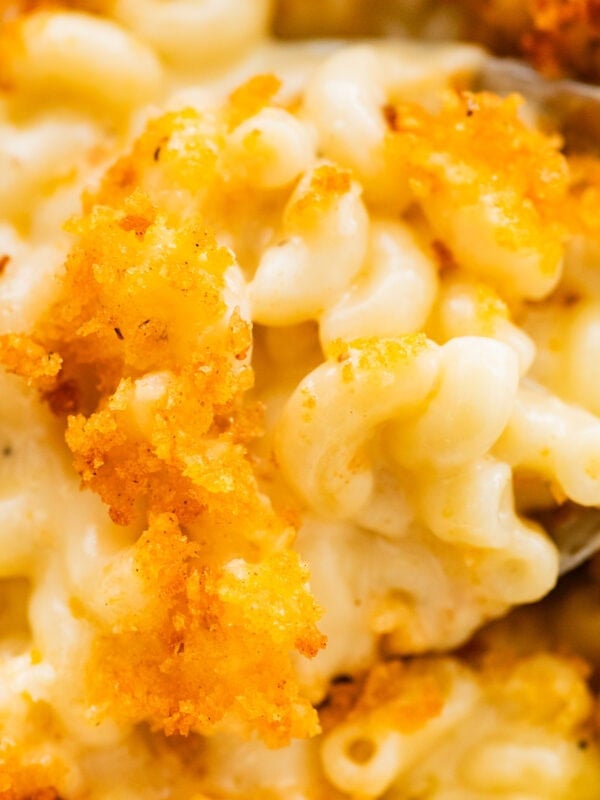
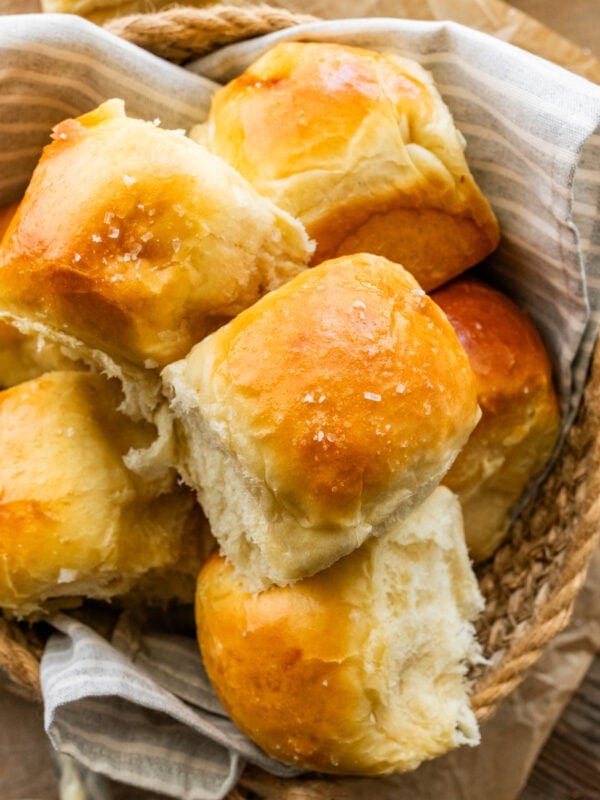
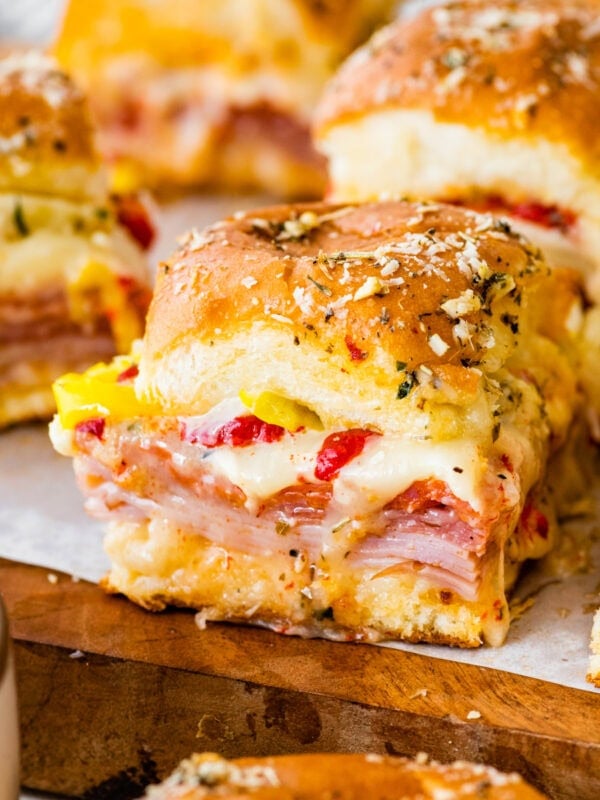
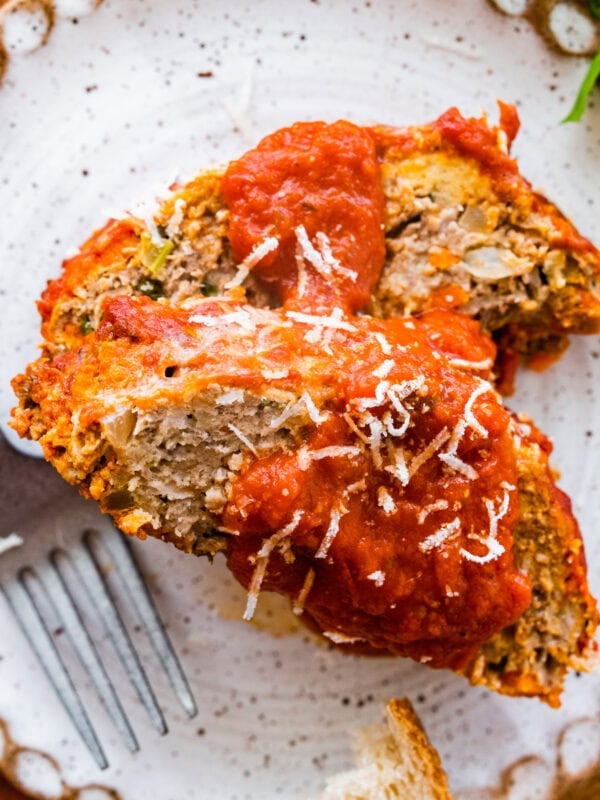




Do you recommend straining the ricotta overnight in the fridge or what the best way to do this.
Yes! That is a great way. Or you can wrap in a cheese cloth and strain it that way!
Simply amazing! We made for the first time and they came out perfect and even impressed Italian family members. Thank you for always having the best recipes. I always say Cucina Elena never lets me down. ❤️
Aww, thanks, Lisa! I am happy you love all the recipes! Yes, these cannoli are so special.